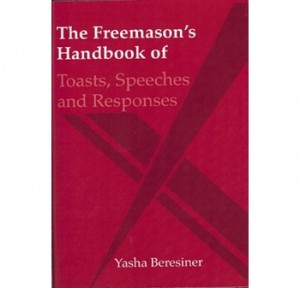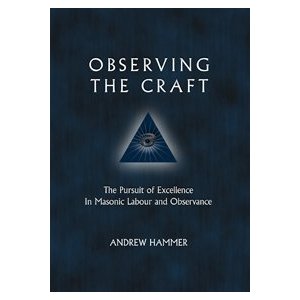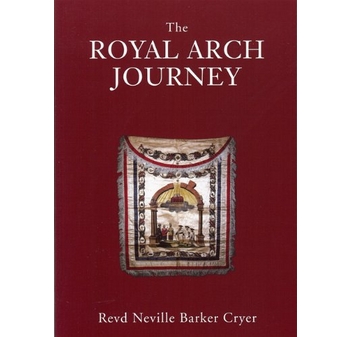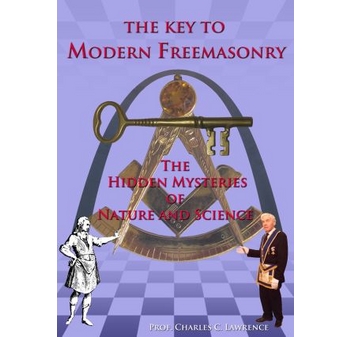 The early days of organised Freemasonry have been neglected for too long, largely because there is not a huge store of documents to be poured over and analysed. What the author has done in this valuable book is to look at the social, political, scientific, intellectual and religious background of the period in which we believe Freemasonry was originating and developing combined with personalities whom we know to have been involved in the early Grand lodge days and the major figures who formed part of their circles. Why are Freemasonry’s rituals laced with scientific concepts and the imperative for learning? Why such a reliance on allegory? Why is the outmoded science enshrined in Ritual so crucial? How did such a dubious group of founders create a brotherhood based on the strictest principles of humanitarian behaviour and why did the intrinsic beauty of the concept far outweigh their shortcomings? Continue reading
The early days of organised Freemasonry have been neglected for too long, largely because there is not a huge store of documents to be poured over and analysed. What the author has done in this valuable book is to look at the social, political, scientific, intellectual and religious background of the period in which we believe Freemasonry was originating and developing combined with personalities whom we know to have been involved in the early Grand lodge days and the major figures who formed part of their circles. Why are Freemasonry’s rituals laced with scientific concepts and the imperative for learning? Why such a reliance on allegory? Why is the outmoded science enshrined in Ritual so crucial? How did such a dubious group of founders create a brotherhood based on the strictest principles of humanitarian behaviour and why did the intrinsic beauty of the concept far outweigh their shortcomings? Continue reading
Author Archives: The Editor
The Freemasons Handbook of Toasts, Speeches and Responses by Yasha Beresiner
This book contains a complete set of fully adaptable toasts and responses to toasts, lasting about four minutes each, that the Freemasons can use at short notice at the festive board. It contains multiple versions of all possible Masonic toasts including, the toast to the initiate, the toast to the guests, the response on behalf of the guests, the toasts to the worshipful master and many more. The book is written in the inimitable style of professional Speechmaker and public speaker, Yasha Beresiner, author of the bestselling Masonically Speaking, which means that each and every toast is witty and entertaining and easy to perform and adapt to one’s own needs. Continue reading
A Pennsylvania Masonic Handbook: The Personal Ahiman Rezon by Robert E. Burtt
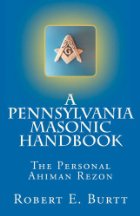
This book answers questions that many new Freemasons have asked themselves: “What do I do now? What are my options in the Brotherhood? Where can I contribute my talents?” Too often, new members are left to search on their own. “A Pennsylvania Masonic Handbook” offers practical advice on lodge membership, covers ritual, and gives thumbnail explanations of Masonic customs and practices within the jurisdiction of The Grand Lodge of Pennsylvania. It also is of interest for worldwide Freemasons seeking knowledge about the customs and history of the largest U.S. Grand Lodge. Furthermore it contains much that would interest the general reader seeking information about Freemasonry. Continue reading
Tracing Boards of Three Degrees in Craft Freemasonry Explained by Julian Rees

Freemasonry is about rendering in symbol and allegory that which words alone cannot render. And a visual image gives us a way of using our own insight to decode the message. The tracing boards are there to do just that — from their original function of laying out the plan of the building, they have developed into a means for us to lay out the message, and then to profit by it.
In a sense, this book is written back-to-front; Julian Rees examines the three Craft tracing boards first, laying out the allegories and symbols, then, as an adjunct, the Author takes a short look at the history of their development, looking at some older forms of the tracing boards in use long before the present-day Emulation boards were developed. After that the book looks at practices in other Masonic jurisdictions and other countries. But the first three chapters of this book deal with the Emulation tracing boards, since they are the most commonly used in England. Continue reading
Observing the Craft: The Pursuit of Excellence in Masonic Labour and Observance by Andrew Hammer
Everything to be found in ‘Observing the Craft’ has been practised in Masonic lodges throughout the world at one time or another. But the reason this book has been written is because so many of these things have fallen out of practice in so many of our lodges, if indeed they have ever been practised in some of them. It is the fervent desire of Andrew Hammer that they may be reconsidered, revisited and restored by those brothers who are inspired and inclined to do so, and thus the intention of this book is to describe these ideas and the reason why it is believed that their practice is indispensable to the Craft.
The first question that many readers may have when encountering this book is What does it mean to “Observe the Craft?” One can argue that from the very beginning of the recognised and verifiable origin of Freemasonry in 1717, there is no one way to do so; there has always been a great degree of variety in how the members of our Craft have understood, manifested and conducted what it is that we are meant to be doing. Continue reading
Masonic Etiquette Today: A Modern Guide to Masonic Protocol by Graham Redman
This book draws together a number of different topics relating to Masonic protocol and provides a comprehensive guide to Masonic behaviour and practice. Topics covered include conduct and issues inside and outside the Lodge, such as dress, regalia, membership, voting, elections, precedence, seating, saluting, general procedures, visiting, behaviour (and difficulties), administrative matters and etiquette at dinner. Continue reading
The Red Triangle: A History of Anti-Masonry by Robert Cooper
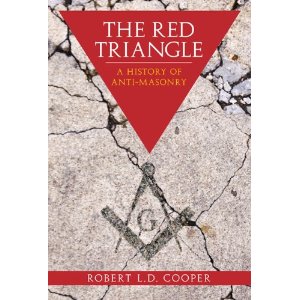 Anti-Masonry (or Masonophobia as it is increasingly being termed) is almost as old as Freemasonry itself but why does it exist and what are the motives of its proponents? Do these change over time and what purpose does it serve?
Anti-Masonry (or Masonophobia as it is increasingly being termed) is almost as old as Freemasonry itself but why does it exist and what are the motives of its proponents? Do these change over time and what purpose does it serve?
These, and other questions, are the subject of this book. Initially the reader is asked to consider some historical examples from the 18th, 19th, and 20th centuries (especially from the Nazi era), and ending with some contemporary manifestations of the phenomenon. Much of the latter is drawn from Cooper’s personal experience in the 1990s and early 2000s.
Attempts to engage in dialogue with Masonophobes in the hope of understanding the motives at play failed but in the process some possible reasons were revealed and these are discussed. Continue reading
Alain Bernheim: le rite en 33 grades, de Frederick Dalcho à Charles Riandey
Prix du livre d’histoire maçonnique 2011
Ce livre, fruit de plus de vingt années de travail de la part d’Alain Bernheim, est consacré à des événements que les francs-maçons dans leur très grande majorité ignorent, car ils ne sont évoqués dans la littérature maçonnique qu’avec de surprenantes erreurs, omissions et approximations. Ils constituent des moments charnières dans l’histoire de ce rite en trente-trois grades qui ne s’appelait pas encore Rite Ecossais Ancien et Accepté lorsque, de Charleston, à l’époque fief de l’esclavagisme, il annonça son existence au monde le 1er janvier 1803.
L’auteur décrit, presque au jour le jour, la genèse et le déroulement du drame qui déchira maçons européens lors de la scission qui amena la création du Suprême Conseil pour la France, il y moins d’un demi siècle. On lira les documents qui établissent dans cette affaire la responsabilité de Charles Riandey, Grand Commandeur du Suprême Conseil de France de son ami le Grand Commandeur du Suprême Conseil des Pays Bas ainsi que celle des Grands Commandeurs des deux Suprêmes Conseils des Etats-Unis d’Amérique. Continue reading
The Royal Arch Journey by Neville Barker Cryer
Over the years the Revd Neville Barker Cryer has delivered many lectures to Lodges throughout the country. His lectures manage to both entertain and inform the lodge members and one perennially popular subject is the Royal Arch Journey. In this volume the author draws on his many years of research into the topic to present an analyis of the history of the Royal Arch, its origins and development, and its place in the present day Masonic tradition. His findings may prove controversial for some as he goes back to its origins in the 18th century but all readers will find this book presents a fascinating and compelling argument. Continue reading
José Castellani, William Almeida de Carvalho: História do Grande Oriente do Brasil
Descrição:
Este é um dos trabalhos mais completos publicados até o momento a respeito da história do Grande Oriente do Brasil (GOB), que mostra os principais acontecimentos que marcaram a trajetória da Ordem e do poder central da Maçonaria brasileira e de sua atuação nos principais fatos políticos e sociais do nosso país, como a Abolição da Escravatura, a Proclamação da República e a Independência do Brasil.
A obra foi escrita por um dos mais respeitados historiadores maçônicos do Brasil, José Castellani, e por William Almeida de Carvalho, que também possui uma bagagem de conhecimento histórico invejável. Todo o trabalho é baseado em documentos oficiais e em longos anos de pesquisas.
Os autores mostram os fatos desde a criação das primeiras agremiações e Lojas que antecederam a fundação do GOB, as dificuldades e as conquistas dos maçons brasileiros dos séculos XIX e XX, estendendo-se até os dias atuais, em que a Maçonaria ainda tem participação em diversos segmentos da sociedade brasileira e o Grande Oriente do Brasil busca deixar ao país o exemplo de seriedade dessa Ordem.


